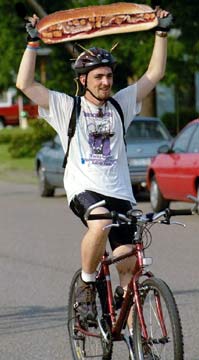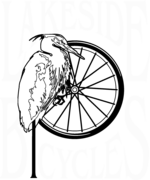Food for Pedaling:
Eat Right To Ride Stronger & Longer 
One of the wonderful fringe benefits of bicycling is having a great appetite and being able to eat what you like (within reason, of course). This doesn't mean, however, that you should bring along your own food log like the guy on the right.
Instead, we recommend carrying energy drink and bars or gels, which are far more convenient, much easier to digest and surprisingly tasty, too. Here are some guidelines on practical eating for cycling.
Keep in mind that the heavier you are and the harder you ride, the more calories you burn. Your body can store roughly an hour-and-a-half to two-hours worth of glycogen (muscle fuel). That's all. So, if you're riding longer, you need to carry food (or stop to purchase it) and consume enough calories to keep from developing a glycogen deficit.
Also, depending upon your sweat rate and the weather, you lose anywhere from 1 to 2 quarts of perspiration an hour. On rides, you must replace this fluid loss with more than just water because you're not only losing H2O, but also vital nutrients.
Beating The Bonk
This glycogen deficit and mineral loss can cause a miserable condition that's known as the "bonk" or "hitting the wall," which feels like you've run out of gas. Your legs feel incredibly weak and small hills become Mt. Everest. You may experience a pins-and-needles feeling in your arms and lightheadedness, even nausea. If you stop for a while, you may get back on the bike and feel fine, only to have the bonk return in just a few minutes. You can even become disoriented and dizzy, which can lead to a crash.
Eat And Drink Right Before, During And After Riding
Eating properly while riding ensures you don't run out of energy and bonk. It's equally important to consume nutritional food before and after rides so that you're ready to ride and recover quickly. Here's an overview of the three types of eating for cycling with suggestions:
1. Pre-Workout Energy
Exercise and heavy eating don't mix, but you need calories to fuel your workouts because not eating can result in you quickly depleting your energy reserves. Plus, some athletes get upset stomachs exercising on empty tanks.
An energy drink specifically formulated for pre-workout can provide easily digested liquid calories designed to enhance endurance. Look for an all-purpose supplement that supplies healthy complex carbohydrates and protein with low sugar and fat. You may find that energy bars, fruit and cereal make good pre-workout meals, too.
2. Energy Replenishment During Workouts And Events
While it's essential to carry food or stop for snacks while riding, what you eat and drink depends on what works for you. Energy drinks are easily consumed (sipping is easier and faster than chewing) and provide fuel in the form of steady complex carbohydrates, as well as replenishing electrolytes and minerals lost through sweating.
You'll also want solid food. Energy bars require more effort to eat than drinks or gels and are best for long, low-intensity rides. Energy gels (similar in form and taste to cake frosting) have become very popular the last few years. These are easy to eat and absorb and provide concentrated carbohydrates that deliver immediate energy during intense efforts. Some varieties include vitamins, amino acids, caffeine and electrolytes.
And remember, that whatever you choose to eat, you must also drink plenty of water, which helps your body more quickly absorb the essential ingredients in energy foods.
3. Eating To Recover
There's a one-hour window of opportunity immediately after workouts when the muscles absorb the most nutrients and when glycogen, the energy reserve in your muscles, is replaced most efficiently. Protein is also important to help quickly repair the trauma your muscles have sustained from firing thousands of times during your ride.
You don't have to eat a big meal, but you should eat something soon after training to recover quickly and store energy for your next ride. Lots of people get good results with a small, high-protein-and-carbohydrate shake. Other carbo-rich foods work well, too, such as a vegetarian burrito. Experiment to see what works best for you.
In fact, two Australian studies have shown that the ideal recovery food, combinging the perfect mix of protien, complex sugars, vitimins, and complex carbohydrates is....Chocolat Milk. We couldn't be happier.
Taking It With You
It's a snap to take along energy drinks and food. Drinks are easy to carry in water bottles. Or, you might prefer wearing a hydration pack, which carries more liquid and includes a delivery hose to make sipping more convenient.
Jersey pockets are designed to carry energy bars, fig bars, fruit or energy gels. Stashed like this, the grub is easily reached while riding, too. Some people use electrical tape to stick packets of energy gel to their top tube or stem for easy access (a good trick for racing). For high-intensity events or rides, energy gels and drinks work better than energy bars. They can be swallowed in seconds (chewing an energy bar can interfere with breathing) and the ingredients enter your system quickly.
Taste Test
Be sure to experiment in training or on rides that are not as important as your big event to make sure that your food and drink choices are right for you. What works for one person won't necessarily work for you. And, twenty miles into a century is no time to find out that the energy drink your training partner recommended upsets your stomach.
We stock a good selection of tasty energy food and drinks. Pick some up soon!
